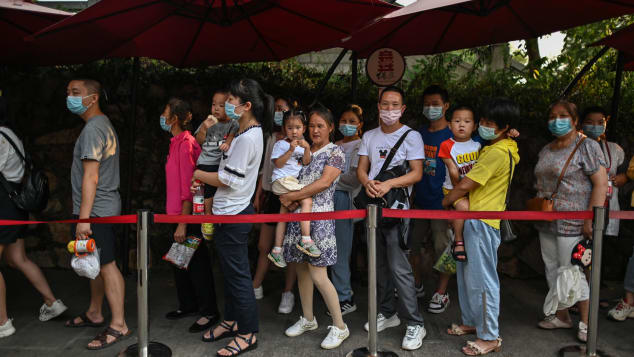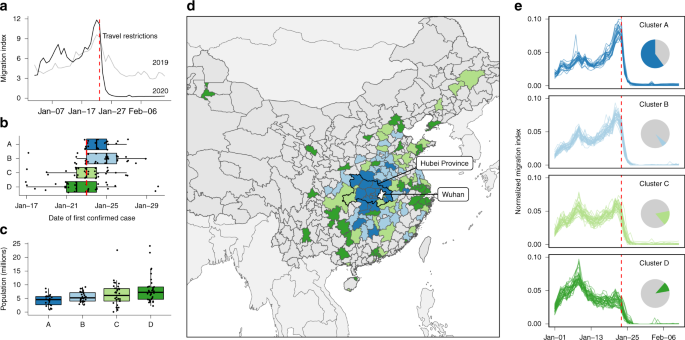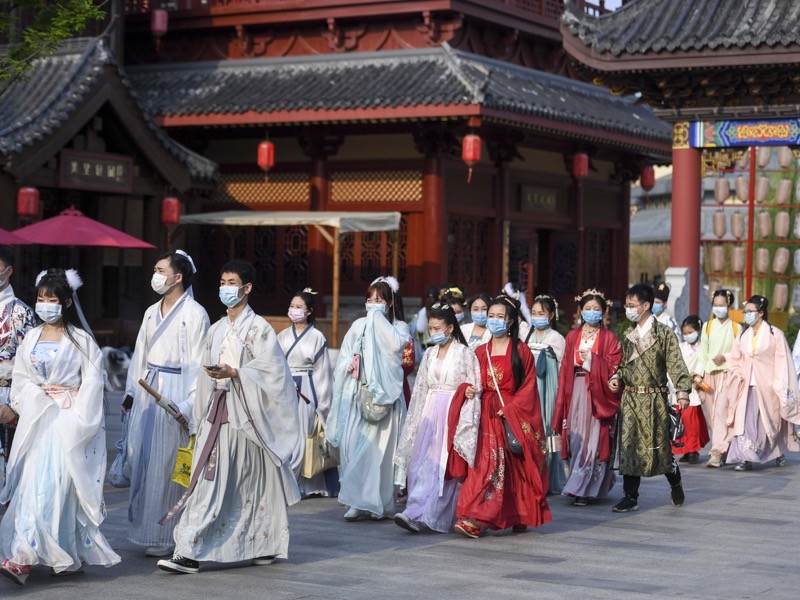Life in Wuhan, China Carries On ...
"Most scientists studying the origins of COVID-19 have concluded that the SARS-CoV-2 virus probably evolved naturally and infected humans via incidental contact with a wild or domesticated animal. But a few persistent voices, including respected microbiologist and biosafety advocate Richard Ebright, PhD, continue to highlight circumstantial evidence suggesting that SARS-CoV-2 escaped from a biohazard laboratory in Wuhan, China. Such an escape might have occurred via accidental infection of a lab worker who came into contact with the isolated virus, an infected lab animal, or animal waste.For now, we cannot definitively rule out either origin story—a lab accident or a natural animal-to-human transmission. Determining the origins of this pandemic is unlikely to help current efforts to treat and cure the disease. It could, however, be an important determinant for efforts to prevent future outbreaks.""Most arguments in favor of the lab accident theory are based on geography. Wuhan, the site of COVID-19’s first reported cases in late 2019, is also home to two of China’s most advanced biological laboratories. The Wuhan Institute of Virology (WIV) has come under special scrutiny because it hosts China’s only biosafety level 4 lab facilities.""Ebright, a former Howard Hughes Medical Institute investigator and current laboratory director at Rutgers University, is the most prominent scientist espousing the possibility of a lab escape. He raised biosafety concerns about WIV when it opened in 2017, as did Tim Trevan, founder of CHROME Biosafety and Biosecurity Consulting. Ebright has long opposed the expansion of preventative research into dangerous pathogens, and he views the possible lab escape of SARS-CoV-2 as strong support for that position."Genetic Engineering & Biotechnology News
"It certainly couldn't have been Wuhan ... surely another person brought it in. Or surely it came from some other product brought from outside.""There were just certain conditions for it to appear here."Chen, wet-market vendor, Wuhan, China"The first cluster of cases was there, so at least it would be of interest to find out the origin of those and put forward a few hypotheses, like whether it's more likely from the wild animals or perhaps points to a human super-spreader."Jin Dong-Yan, professor of virology, University of Hong Kong
"There is new evidence to show that China locked down all domestic traffic internally by end January 2020 but pushed to open foreign travel till end March. Data from Tom Tom traffic index, a traffic location site that covers 416 cities across 57 countries show that as a result of this strategy, China, intentionally or otherwise, was able to lockdown its cities unknown to the world. While this reduced the spread of the Corona virus within China, China’s aggressive foreign travel policy lead to a virus explosion worldwide."Sandip Sen, The Economic Times, April 30, 2020
" |
Tourists wearing face masks line up outside the Yellow Crane Tower in Wuhan, China on September 3. HECTOR RETAMAL/AFP/AFP via Getty Images |
The
Huanan Seafood Wholesale Market in Wuhan, China where vendors set up
their wares in small stalls was a popular place for individuals to shop
as well as local restaurant owners who would start their day by passing
through the market to pick up fresh-caught fish and bring it back to
their restaurants to begin the day's menu preparations. Most Asian
cities have such live markets, Tokyo, Japan has a large celebrated
market, Ueno district's Koromon market, where crowds of shoppers
converge on the market to sample live fish. These markets are part of
the food culture, a part of daily shopping life.
On
December 31, 2019, four cases of a mysterious type of pneumonia
appeared at local Wuhan hospitals and were linked to the Huanan market
and overnight it was no longer open for business, taking shoppers by
surprise the following morning. A month later, the city went into a
strict 76-day lockdown on hours' notice, barring people from leaving
their homes. A severely restrictive move that represented the start of a
hugely successful gambit to control the new virus's spread. Hubei
Province itself was border-shuttered to the rest of China.
 |
On
the other hand, China kept its national borders open so Chinese could
celebrate the Lunar New Year as usual, and the population spread out in
its customary holiday travel pattern as millions of Chinese travelled
back to their home cities and provinces in a tradition as important to
the Chinese as Christmas is to Westerners. A massive human migration
takes place as individuals travel back to
their hometowns. People in China are estimated to make close to 3
billion trips over the 40-day travel period, or Chunyun, of the Lunar
New Year holiday. It's estimated that 5 million people left Wuhan, the
epicentre of the pandemic before the travel ban of January 23, 2020. An estimated million Chinese went abroad, to Europe and elsewhere during that period.


The
disease spread rapidly throughout China and to neighbouring countries.
Despite the aberration of the massive migration for the Lunar New Year
celebrations, China and its neighbours then cracked down on their
populations, enacting draconian social distancing laws and total
lockdowns. Their success in bringing the internal spread of the disease
following a massive infection rate in China which led to hastily built
hospitals to handle the load and patients being isolated in massive
temporary quarters with cots lined up one after another in proximity to
one another, did succeed in eventually quelling the massive outbreak.
Which
then spread to Europe, devastating the continent which is now grappling
in desperation with its second and third waves of the domineering
recurring nightmare. Globally, over one-and-a-half million people have
died of the effects of SARS-CoV-2. Initially, Beijing had bristled at
the global community's attempts to close their borders to Chinese
visitors, claiming the move was clearly racist in nature; even the World
Health Organization supported China's umbrage, chiding the rest of the
world for their reaction. The United States now hosts a ravaging beast
of a pandemic.
When
both Beijing and the WHO came under criticism, particularly from the
U.S. administration, both bridled and responded they had each acted with
alacrity to stem the tide of the viral contagion, acting with due
respect and regard to public safety globally. China took further umbrage
when the virus was referred to as the China virus, and the WHO came up
with a neutral designation for the scourge. To their credit, Chinese
scientists released to the world at large the genetic sequence of the
virus, enabling scientists elsewhere to get on with research to find a
vaccine against the virus.
In
Wuhan, the city is once again 'normal'. But the wet market remains
closed, the stalls shuttered. The origin of the virus remains a topic of
fierce political and scientific enquiry. Beijing circulated the claim
that the virus originated elsewhere, in Spain or Italy, and was then
brought to China where it surfaced to appear as the origins of the
virus. Residents of Wuhan certainly don't believe the virus really
originated there, but was brought to the city by travellers. When a
second wave erupted in China, a strain of the virus brought back by
Chinese returning from trips abroad again, it gave impetus to the notion
that the virus originated abroad.
Beijing
and the United States continue to spar with one another along with
other countries, accused by China of bias against the Chinese. Even yet,
a team of World Health Organization experts has still to visit Wuhan to
gather information. Origin-tracing efforts, warn health authorities in
China and elsewhere, could take years and in the end inconclusive
results may be yielded. More recently Chinese diplomats and state media
claim their belief the market was not the origin of the virus but the
victim of the disease, which originated somewhere other than China.
According
to experts the market is critical to any investigation, unlikely to be
dismantled even though the bulk of the research would rely on samples
sored immediately following the outbreak. Access to the market area is
heavily restricted. The bustling building with its hundreds of stalls
sectioned off into areas for red meat, for seafood, and for vegetables
is now quiet and abandoned. Local government has placed traditional
Chinese paintings over the semi-permanent blue barricades the area is
encircled by. Wooden boards line the interior stalls and windows.
 |
| Chinese tourists crowd together on the Badaling section of the Great Wall of China in Beijing on October 4, 2020. (Kevin Frayer/Getty Images) |
"A report issued by a Shanghai-based online travel agency said people from over 100 Chinese cities had booked to travel to nearly 500 destinations across over 90 countries and regions.""Thailand, Japan, Indonesia and Singapore are among the most popular destinations while Nordic countries, the United Arab Emirates and Spain have seen the fastest growth of Chinese visitors"."Traveling schedules covering cultural sites or winter sports that can be enjoyed by a big family are the most popular choices, indicating that Chinese are willing to enjoy high-quality travel experiences.""Lvmama, another Shanghai-based online travel agency, said in its latest report that more convenient transport, easier visa application procedures and Chinese people's upgrading demand for leisure were major factors in China's booming outbound tourism.""In 2018, 140 million Chinese traveled outbound, marking a year-on-year increase by 13.5 percent, according to the China Tourism Academy."XinhuaNet, December 13, 2019
Wuhan
has not reported any new locally transmitted cases of COVID-19 since
May. A local restaurateur speaks of the market's closure and public
panic over the safety of imported seafood, increasing the cost of
ingredient procurement substantially. Above the empty, closured market,
shops reopened in June selling optometry equipment and eye-ware. Guards
at the upper entrance to the market take temperatures, warning that no
videos or photos may be taken inside the building. "Maybe
some people have some bad feelings about it, but now it's just an empty
building ... who feels anxious about an empty building?" a shop assistant remarked.
 |
Labels: China, COVID Origins, SARS-CoV-2, Virus Transmission, WHO, Wuhan City

<< Home